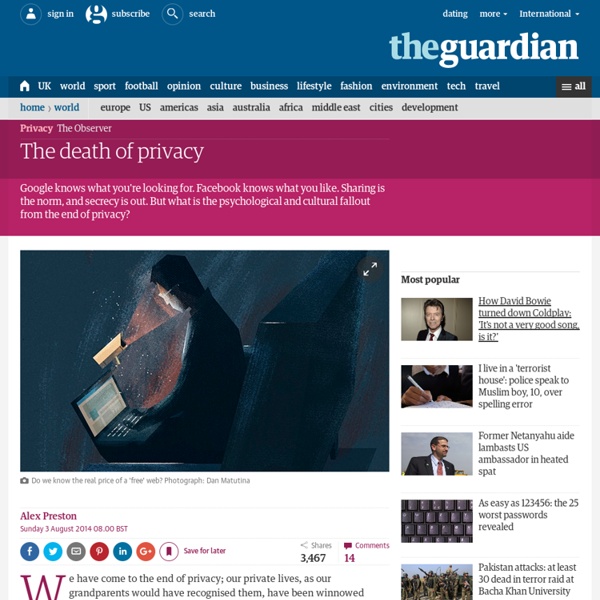As easy as 123456: the 25 worst passwords revealed | Technology
Good news! People are still astonishingly bad at picking secure passwords, and if you run your fingers across the top row of your keyboard, you will probably type seven of the 15 most-used passwords at once. When we say “good news”, we mean “good news for people who want to break into password-protected accounts”, of course. If you are one of the people with a bad password, that is very bad news indeed. Password management firm SplashData has compiled more than 2m passwords leaked over the course of 2015, to find the 25 worst passwords – those used by the most people at the same time. Topping the list for yet another year is the gold standard of awful passwords, 123456, while hot on its heels is perhaps the only password worse still: password. Of course, there will always be some passwords which are the most used passwords. But Brian Spector, the chief executive of security firm Miracl, argues that the list is yet more evidence that passwords are broken altogether. 1) 123456 (unchanged)
Would The Real ‘Alec Couros’ Please Stand Up?
Last September, I wrote a post about how scammers had been using my photos to lure women into online, romantic relationships for the purpose of ‘borrowing’ or extorting money. Since that time, the scams have continued. I get, on average, one new report a day from women (and occasionally men) who have been tricked, or nearly tricked, into sending money. These scams are likely not perpetrated by a single individual. Searching ‘alec couros’ on Skype gets these resultsThese fake accounts are often deliberately difficult to detect because the scammers have blocked you from them. Likely, what I’ve learned the most throughout this predicament is that we need better systems for identity verification. Now, please share this post (or the key ideas within) with your colleagues, parents, friends, children, students, etc.
Lessons learned from social media identity theft - Regina
MOOSE JAW – Kathy Cassidy has over a dozen followers in her grade one classroom at Westmount Elementary School in Moose Jaw. Online, she has over 8,000. But that popular identity was stolen. “The first feelings are panic and betrayal,” Cassidy said. “You feel so vulnerable.” An imposter quickly gained hundreds of Twitter followers, while posting crude and offensive things that Cassidy – a classroom technology advocate – never would. “It had the same photo, the same header, same background picture, the same biography, the same links,” she said. “The only thing different was the username.” Duplicating an online profile only takes seconds, according to Alec Couros. The social media expert and University of Regina professor says a well-known identity on the web not only fuels impersonation, but is also the solution. “To be able to say, ‘I know this person, I know that’s not this person who is online, that you’re being impersonated,’ is the number one skill to have,” said Couros. 1. 2. 3.
No, You Can’t Use My Photo for Your Fake Identity, and No, I Can’t Prevent It
That’s my photo, but that’s not my name or occupation. My mug has been hijacked by someone pretending to be someone who does not exist. Like many of you, I had no idea this kind of thing went on. It’s called Catfishing. Welcome to the dark underbelly of openness. I’ve read with the greatest respect how Alec Couros has dealt with this. It’s happened a lot to Dean Shareski, too. Maybe it’s just Canadian educators who’s photos get stolen to create fake online identities to lure woman on dating sites to somehow con them. It’s the kind of thing that makes you say ‘GROSSSSSS’. My number came up today; a fellow flickr user sent me a message to say she had seen my photos reported on romancescam as some dude named David Frederickson (not the most suave non de plume -why is it not Dirk Savage, or Hank Grockman), with links on Facebook and LinkedIn. This is the photo David is using to be me. creative commons licensed ( BY-SA ) flickr photo shared by cogdogblog But what I can do is ask for help and
How do I permanently delete my account? | Facebook Help Centre
Download your data - Accounts Help
Important: If you download your Google data, it doesn’t delete it from Google’s servers. Learn how to delete your account or how to delete your activity. You can export and download your data from the Google products you use, like your: Email Documents Calendar Photos YouTube videos Data about registration and account activity To keep for your records or use your data in another service, you can create an archive. Important: If your actions seem risky, in order to protect your account, your actions may be delayed or unavailable. Tip: If you can't find some of your videos, check if you have a Brand Account. Step 1: Select data to include in your download archive Go to the Download your data page. Step 2: Customize your archive format Delivery method** Send download link via email We'll email you a link to download your Google data archive. For "Delivery method," select Send download link via email. Add to Drive We'll add your archive to Google Drive and email you a link to its location. Notes 1.



